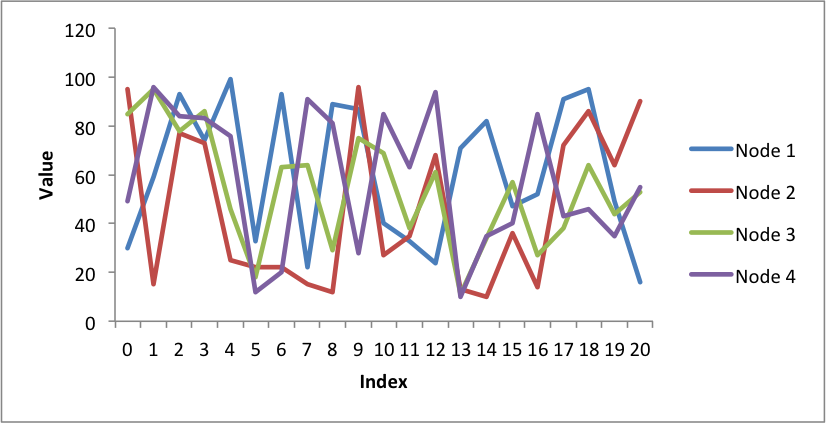Example: Pandas Excel output with a line chart#
A simple example of converting a Pandas dataframe to an Excel file with a line chart using Pandas and XlsxWriter.

##############################################################################
#
# An example of converting a Pandas dataframe to an xlsx file with a line
# chart using Pandas and XlsxWriter.
#
# SPDX-License-Identifier: BSD-2-Clause
# Copyright 2013-2024, John McNamara, jmcnamara@cpan.org
#
import pandas as pd
import random
# Create some sample data to plot.
categories = ["Node 1", "Node 2", "Node 3", "Node 4"]
index_1 = range(0, 21, 1)
multi_iter1 = {"index": index_1}
for category in categories:
multi_iter1[category] = [random.randint(10, 100) for x in index_1]
# Create a Pandas dataframe from the data.
index_2 = multi_iter1.pop("index")
df = pd.DataFrame(multi_iter1, index=index_2)
df = df.reindex(columns=sorted(df.columns))
# Create a Pandas Excel writer using XlsxWriter as the engine.
sheet_name = "Sheet1"
writer = pd.ExcelWriter("pandas_chart_line.xlsx", engine="xlsxwriter")
df.to_excel(writer, sheet_name=sheet_name)
# Access the XlsxWriter workbook and worksheet objects from the dataframe.
workbook = writer.book
worksheet = writer.sheets[sheet_name]
# Get the dimensions of the dataframe.
(max_row, max_col) = df.shape
# Create a chart object.
chart = workbook.add_chart({"type": "line"})
# Configure the series of the chart from the dataframe data.
for i in range(len(categories)):
col = i + 1
chart.add_series(
{
"name": ["Sheet1", 0, col],
"categories": ["Sheet1", 1, 0, max_row, 0],
"values": ["Sheet1", 1, col, max_row, col],
}
)
# Configure the chart axes.
chart.set_x_axis({"name": "Index"})
chart.set_y_axis({"name": "Value", "major_gridlines": {"visible": False}})
# Insert the chart into the worksheet.
worksheet.insert_chart(1, 6, chart)
# Close the Pandas Excel writer and output the Excel file.
writer.close()